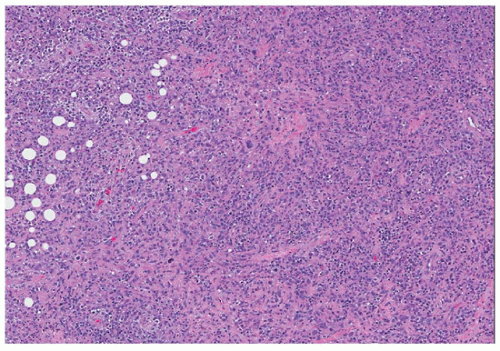Mediastinal Gray Zone Lymphoma (B-Cell Lymphoma, Unclassifiable, with Features Intermediate Between Diffuse Large B-Cell Lymphoma and Classical Hodgkin Lymphoma)
Borislav A. Alexiev, M.D.
Rima Koka, M.D., Ph.D.
Terminology
Mediastinal gray zone lymphoma (MGZL) has transitional morphologic and immunophenotypic features between the nodular sclerosis subtype of Hodgkin lymphoma and primary mediastinal large B-cell lymphoma.1,2,3,4 Diagnostic criteria for MGZL are still being defined, and the optimal therapy is as yet undetermined.5,6
Incidence and Clinical
Clinical features of MGZL include young age, male predominance, and localized mediastinal presentation.2,5,6 MGZL commonly presents as a bulky lesion in the anterior-superior mediastinum with symptoms related to local invasion or compression. Most reported cases have been in adults. MGZL is very rare in children.3
Gross Pathology
The lymph nodes are markedly enlarged. The cut surface is yellow-tan with hemorrhages and necrosis.
Microscopic Pathology
The lymphoma demonstrates a sheet-like growth pattern of pleomorphic neoplastic cells, sometimes in a fibrotic stroma. The neoplastic cells are large and pleomorphic, resembling lacunar Reed-Sternberg cells and Hodgkin cells (Figs. 133.1 and 133.2). A characteristic feature is the broad spectrum of cytologic appearances within different areas of the tumor. Some areas may more closely resemble classical Hodgkin lymphoma, while others appear more typical of diffuse large B-cell
lymphoma. Necrosis is frequent. A sparse inflammatory infiltrate may be seen, including small lymphocytes, plasma cells, histiocytes, and eosinophils.4
lymphoma. Necrosis is frequent. A sparse inflammatory infiltrate may be seen, including small lymphocytes, plasma cells, histiocytes, and eosinophils.4
 FIGURE 133.1 ▲ Gray zone lymphoma of the mediastinum. The tumor forms sheets, with occasional large pleomorphic cells.
Stay updated, free articles. Join our Telegram channel
Full access? Get Clinical Tree
 Get Clinical Tree app for offline access
Get Clinical Tree app for offline access

|